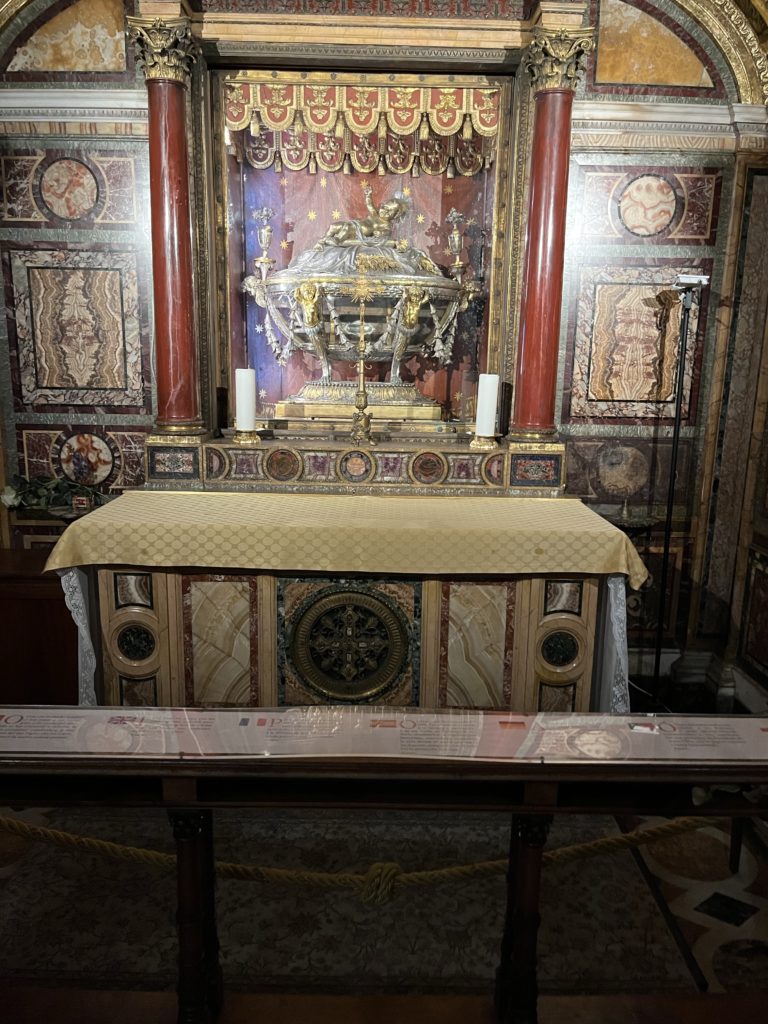
Today was a free day. Even on these study tours we have free days so each can go their separate ways. It is the way of creation: form and freedom. There is structure, but within the structure there is freedom. Too much form and we become nazis; too much freedom and we become hippies. So, today the females of the GSB team chose to shop, and I chose a few places off the beaten tourist path, and I am glad I did.
I started at the Basilica of St. Clement, which is located near the Colosseum and purportedly holds the remains of Clement. Clement was the head of the church of Rome, beginning in 88 A.D. until he was banished by Trajan and later martyred in the Crimea, when he was thrown into the sea tied to an anchor. St. Cyril supposedly brought Clement’s remains back to Rome from the Crimea in the 9th century. One of the members of the GSB team asked at dinner how Cyril knew they were the remains of Clement. The GSB research division is still looking into this.
The tomb and remains of St. Cyril are at the Basilica of St. Clement, and this was the real find. I have blogged on Cyril here before because he and his brother Methodius changed a nation for the Kingdom. Both are Kingdom heroes.
Below the Basilica of St. Clement you can explore the Temple of Mithras, which was converted into a church in the 4th century, and under that there are first century homes which even have running water from the aqueduct. It is well worth the 10 euros.
I then walked to the Basilica of St. Maria Maggiore, where I happened upon the skeleton, in full papal garb, of Pope Pius V, in “full repose,” as they say, in a glass case for all to see. Note: Parental discretion is advised. This is not Disney World after all.

Pius V (1504-1572) was pope during the Counter-Reformation. He opposed corruption in the Catholic church, but he also excommunicated Elizabeth I of England. So, the GSB team is officially ambivalent toward Pius V.
Of more questionable origin was the alleged crib of the baby Jesus–the “true crib,”–encased in glass and, I must say, in remarkably good shape after 2,000 years of wear. For the curious, it is located at the front of the church under the altar, but I wouldn’t get too excited about it. I rate the true crib up there with the true diaper and true sponge we saw in Aachen, Germany–it is neither true, nor a crib…discuss. However, having now seen all three, I feel I have achieved the pilgrimage equivalent of the NBA triple double. I next plan to apply for beatification and, thereafter, sainthood.

Less than one 100 yards from St. Maria Maggiore, but hiding behind the buildings lining the street is the Basilica of St. Praxedes. It is difficult to find because it is now flush against other buildings and has no profile, which from any view looks like a church.
The Apostle Paul wrote to his disciple Timothy:
“Make every effort to come before winter. Eubulus greets you, also Pudens and Linus and Claudia and all the brethren.”
I Timothy 4:21
Pudens was the son of a Roman senator, and he and his wife were purportedly among the first persons Peter led to the Lord in Rome. Pudens was martyred under Nero, and his daughter was martyred as well. Her remains and those of her sister, Prudentiana, are at the church in a shrine dedicated to them under the altar.

St. Cyril and St. Methodius apparently also lived here while they were in Rome, and Alfred the Great, the future first Christian king of England, visited here as a child and apparently was deeply impressed.
Lastly, I would be remiss–or maybe I wouldn’t — if I didn’t mention the most famous relic of this church: a marble post to which Jesus was allegedly tied when he was whipped by Romans before His crucifixion. The mosaic ceiling in the shrine makes it worth a look, and if you want your credulity strained beyond the breaking point, take a peek at the post in the glass case. Otherwise, just admire the mosaic and think about what is real: that the Pudens family, two brothers who became missionaries to Moravia, and a future king of England, all greatly advanced the kingdom of God and all where once here. GS
